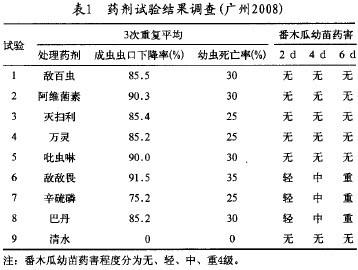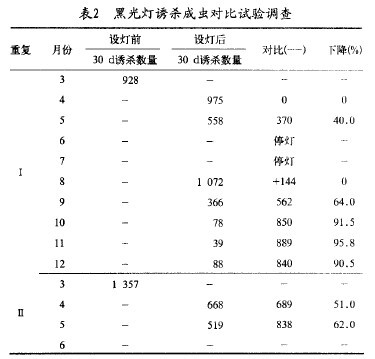Several Different Control Techniques of Papaya Mosquito
Papaya Mosquito is a new pest that has been found by the authors at the Papaya Nursery Base in Guangzhou. The adult worm lays eggs on the leaves and young stems of the seedlings. The larvae feed on the young stems, causing the seedlings to wither, break off, and die, which seriously affects the papaya factory seedling production and causes economic losses in scientific research and production. In order to explore measures to control the damage of insect pests as soon as possible and prevent the pests from continuing to develop, research on the pest control techniques was carried out while research was conducted on the biological characteristics of the pests.
8 kinds of pharmaceutical reagents: (1) 90% crystal trichlorfon, (2) 1.8% abamectin EC, (3) 20% desflurane EC, (4) 20% panacea, ( 5) 2.5% imidacloprid wettable powder, (6) 80% dichlorvos EC, (7) 40% phoxim, (8) 50% Bataan WP. Light trapping experiments using adult phototaxis, the use of insecticidal lamp, trapping experiments.
Pharmacodynamic Test Methods In the nursery greenhouse, a total of 27 Papaya seedlings with the same number of seedlings and the same number of growing seeds were selected, with 24 strains per plate and a total of 648 strains. According to the test reagent 8, another water control, set a total of 9 plots, each zone is set to repeat 3 times, every 1 repetition for 1 set, sharing 27 discs. According to the serial number of the test drugs, they are arranged as the area code, leaving a protection line between the cells. Then use the concentration of the agent to turn it into a liquid and spray it with a handheld sprayer. The time of spraying was 1 for adults and 1 for larvae (2-3 years). Two investigations were conducted on 2, 4 and 6 days after spraying to analyze the control effects of each insect state and each agent. Investigation method for the effect of trapping and killing adults 10 insecticide lamps were installed in the nursery greenhouse (667m2). From April 1st onwards, lights are turned on every night from 18:00 to 6:00, and two 15cm x 20cm yellow insect traps are used to attract insects. Based on the number of trapped insects of 2 repetitions (it is difficult to directly record the number of trapping insects due to the small size of the insects), the number of trapping insects in March before the lamp is used as a base, and the trapping of insects in April and June after the lamp is set. Number, calculate the rate of decrease of the density of insect population, indicating the control effect.


After the effects of 8 pesticides were tested, the results of 2, 4, and 6 days showed that the pesticides had a significant effect on adults and the population density decreased by 85% to 90%. The effect on larvae is poor and larval mortality is below 30%. The No. 1 to No. 5 agents (trichlorfon, avermectin, chlorbenzolid, vanillin, and imidacloprid) showed no phytotoxicity to the papaya seedlings, and the 6-8-g-drugs (dichlorvos, phoxim, and babarium) Dan) has serious injury to Papaya seedlings (see Table 1). The results of the trapping and killing adult test were conducted from March 3rd to 31st, 2008. The number of insect traps on the two yellow plastic sheets was 928 (I) and 1357 (II), respectively. After the installation of black light lamps on April 1, the number of trapped insects in April was 975 (I) and 668 (II) respectively, and the decline in insect population was 0 and 51.0%, respectively, with an average of 25.5%. The number of trapping insects in each month after September was gradually reduced to 90% (see Table 2). The test results show that with the naked eye on-site observation and comparison of test data, it can be seen that the black light trapping adult has a significant effect.
Based on the results of a number of trials and studies, combined with the hazard characteristics of Papaya species, we have formulated “to maintain the cleanliness of nursery greenhouses, and the number of nursery groups is not overdispersed, based on the application of black light lamps to trap adult insects, and to grasp the peak time of adult occurrence. Integrated prevention and control technology for safe and low-toxicity pesticide production for papaya. Specific measures: (1) Keeping the nursery greenhouse clean: Clean the greenhouse before or during nursery. Dichlorvos can be used insecticide, or phoxim mixed fungicides carbendazim, thiophanate or chlorothalonil greenhouse disinfection, reduce the greenhouse pests and diseases. (2) Adjust the number of nursery batches: Greenhouse nursery should adjust the number of batches as much as possible, and should not be excessively dispersed. Otherwise, it will easily lead to rich foodstuffs in the room, which will facilitate the breeding of pests and increase the number of them. (3) Application of black light traps to kill adults: 3 to 4 black light lamps are installed in greenhouses of 667m area to trap and kill adult insects. In addition, black light can be used as a forecasting tool to predict the peak period of adults and guide the control of pesticides. In addition, insect traps can be used to trap adult insects, or mosquitoes can be directly disinfested to reduce the population density of adult insects in the field. (4) Apply pesticides in a timely manner: Grasp the peak period of adult emergence, and apply 1-20 to the seedbeds and seedling nursery in time. Pharmacists may choose to use effective and safe non-environmental agents such as trichlorfon, avermectin, chlorbenzolid, and vanillin.
Through studies on the efficacy tests of black ray lamp mosquito traps and other studies, we have clarified the prevention and control effects of non-environmental pesticides such as trichlorfon and avermectin, as well as the trapping effect of adult worms, and put forward comprehensive control technologies including multiple measures. . Comprehensive prevention technology measures have been popularized and applied in nursery bases for more than one year. The effect of prevention and control has been remarkable, the density of insect population at the base has been significantly reduced, and the hazard rate of seedlings has decreased significantly. This has ensured the smooth progress of factory seedling production and scientific research projects and saved the economy. Loss and research losses. In the future, we must continue to implement and improve the comprehensive prevention technology, control the new pests of Papaya quinquefascia to the minimum range, control the hazard rate in the economic zone, and prevent proliferation and harm to production. At the same time, we must continue to carry out research on this insect prediction and forecasting technology to provide scientific basis for prevention and control work.
The chemical compound Trichloroethylene Detergent is a halocarbon commonly used as an industrial solvent. It is a clear, colourless non-flammable liquid with a chloroform-like sweet smell. Trichloroethylene Price should not be confused with the similar 1,1,1-trichloroethane, which is commonly known as chlorothene.
The IUPAC name is trichloroethene. Industrial abbreviations include TCE, trichlor, Trike, Tricky and tri. It has been sold under a variety of trade names. Under the trade Melamine Powder names Trimar and Trilene, Trichloroethylene Chemical was used as a volatile anesthetic and as an inhaled obstetrical Sodium Hexametaphosphate analgesic Trichloroethylene For Hospital in millions of patients.
Groundwater and drinking water contamination from industrial discharge including trichloroethylene is a major concern for human health and has precipitated numerous incidents and lawsuits.
Dry Cleaning Trichloroethylene is an effective Solvent Raw Material for a variety of organic materials.
Trichloroethylene Detergent,Trichloroethylene Price,Trichloroethylene Chemical,Trichloroethylene For Hospital,Dry Cleaning Trichloroethylene
HENAN LIHAO CHEM PLANT LIMITED , https://www.lihaochemicals.com
